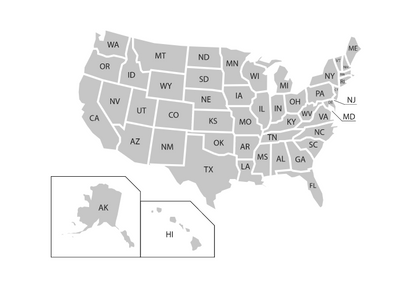Christina Liu | Scientific Contributor
The Natural Resources Defense Council (NRDC) released a recent analysis of EPA lead data. NRDC found that 186 million people across the United States were exposed to elevated lead levels through their drinking water systems.The EPA, CDC and the American Academy of Pediatrics all recognize that there is no safe level of lead for children. This article breaks down important findings from this study and what they mean for your drinking water.
1. Lead in Drinking Water Is a Significant Issue in Many Parts of the Country
- 186 million people in the United States between January 1, 2018 and December 31, 2020 drank water that exceeded the pediatrician recommended maximum lead level of 1 part per billion (ppb).
- 28 million people were served by drinking water systems that totaled 12,892 lead violations.
- Seven million people drank water that exceeded EPA’s Lead Action Level of 15 ppb.
- The CDC and the American Academy of Pediatrics have stated that there is no safe level of lead for young children. The EPA has also set the maximum contaminant level goal (MCLG) for lead in drinking water at 0 parts per billion because lead can be harmful to human health even at low exposure levels.
2. Do Federal Laws Protect You From Lead Exposure in Drinking Water?
Unfortunately, no. The Lead and Copper Rule (LCR) was first enacted in 1991 and has seen minimal changes since then. It is the only major regulation aimed at protecting the public from lead exposure in drinking water. It does however contain loopholes, exemptions, and regulatory flaws which demonstrate that the LCR does not necessarily prioritize human health. The most obvious and deceptive flaw is the 90th percentile rule, which states that only 90% of samples must meet EPA’s 15 part per billion “Action Level (AL)” threshold. This means that 10% of samples can exceed the AL threshold and still be in compliance with the law.
3. My Water Source is Completely Clean. Do I Still Have To Worry About Lead?
Lead contaminates tap water differently than most pollutants, because lead comes from plumbing - not the water supply. Water leaving the treatment plant can be entirely lead-free but becomes contaminated once it hits older infrastructure. For example, some buildings in older neighborhoods have lead-containing service pipes that connect water mains to the residential plumbing, and plumbing installed before 1986 often used lead-containing solder to join copper pipes. If corrosion control measures fail (what happened in Flint, MI), lead can leach from the pipes into the tap water. This problem is exacerbated when water sits stagnant for several hours before use (e.g. overnight or while resident is at work), because lead concentrations rise as corrosive water sits in the pipes.
Case Study: New York City
New York City provides municipal tap water for more than half the population of New York, through an impressive network of 19 reservoirs and 3 lakes. New York City’s tap water is widely recognized in the water industry as the “Gold Standard” for urban water providers (it’s truly an engineering feat on an unimaginable scale). However, even if the water leaves the reservoirs and water plants lead-free, lead contamination occurs when the water encounters aging pipes and connections that contain lead. In the table below you’ll notice several samples are well over the federal Action Level - some are over 300 times higher than the 15 part per billion threshold.
Table 1. New York City lead levels from 2007 - 2022
4. Does The American Jobs Infrastructure Plan Go Far Enough To Reduce Lead Exposure?
The American Jobs Plan includes $111 billion in funding for water infrastructure. $45 billion of this is being allocated to eliminate ALL lead pipes and service lines. That is a significant promise, but not a lot of money with which to accomplish this. An estimated 6-10 million homes in the U.S. still receive their drinking water from a lead pipe or lead service line. In addition, the process of replacing city-wide distribution lines will be invasive and time-consuming. It involves digging up streets, section by section, across an entire city. Individual homeowners also need to hire a specialist to replace their lead service lines to avoid potential exposure to this known neurotoxin. Also, lead levels increase for the first few months after a service line is replaced. We have an article that goes in depth as to why this is, which you can find here. Unfortunately, if you currently have lead service lines that bring water to your home, while you may experience relief (new pipes) in the future, this won’t be an immediate fix.
What can I do?
-
Get informed. Look up the water quality report in your area. See if your water supplier is one of the ones mentioned in the NRDC study. Information on lead in drinking water, testing methods, and steps you can take to minimize exposure is available from the Safe Drinking Water Hotline or on the EPA’s page: Basic Information about Lead in Drinking Water.
-
Get your water tested for lead. Many cities have free lead testing kits or lead testing services. Check your city’s website or water quality report for information. Please take advantage of these resources if they are available to you.
-
Flush your tap before using water for consumption. If your water has been sitting for over six hours, minimize the potential for lead exposure by flushing your tap for a minimum of 5 minutes before using water for drinking or cooking.
-
Use cold water. Use only cold water for drinking, cooking and making baby formula. Hot tap water is known to cause lead to leach from your home's pipes.
-
Check your Filters. If you are using a filter for your drinking water, please verify that it is certified for lead removal.
How Can Hydroviv Help Me?
Hydroviv is a water filtration company that uses water quality data to optimize water filters for each customer's water. In addition to lead, we use the water quality data for each location to determine what we consider to be major “points of emphasis” that we use to build water filters that are built specifically for municipal water in your area as well as for private wells.
If you’re interested in learning more about water filters that have been optimized for your municipal tap water or private well, or just have questions about water quality in general, feel free to visit www.hydroviv.com, reach out by email (hello@hydroviv.com) or through our live chat. We post water-related news on Twitter, Instagram, and Facebook.
Hydroviv's drinking water filters carry NSF certifications to Standard 42 (aesthetic effects--Chlorine Removal) and Standard 53 (health effects--Lead, VOCs, and PFOA/PFOS removal), and are independently tested to remove hundreds of contaminants.
Other Articles We Think You Might Enjoy:
PFAS and The Safe Drinking Water Act
Disinfection Byproducts in Drinking Water: Toxicity, History, and Policy
Does Boiling My Water Purify It?





